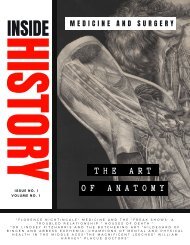Inside History: Protest. Revolt & Reform
For our next issue we take a closer look at the theme of Protest from the events of Peterloo to the fall of the Berlin. Inside we cover a whole range of historical protests and the individuals who led the charge for change. This issues includes: John Brown's raid on Harpers Ferry, The Suffragettes, Billie Holiday and the role music has played in protests, The Civil Rights Movement, Protest and Sport, We are the People: The Fall of the Berlin Wall, Bloody Sunday at Trafalgar Square, and much much more.
For our next issue we take a closer look at the theme of Protest from the events of Peterloo to the fall of the Berlin. Inside we cover a whole range of historical protests and the individuals who led the charge for change. This issues includes:
John Brown's raid on Harpers Ferry, The Suffragettes, Billie Holiday and the role music has played in protests, The Civil Rights Movement, Protest and Sport, We are the People: The Fall of the Berlin Wall, Bloody Sunday at Trafalgar Square, and much much more.
- No tags were found...
Create successful ePaper yourself
Turn your PDF publications into a flip-book with our unique Google optimized e-Paper software.
or risk a hard cold winter without any steady income. By
February 1910, thousands of strikers returned to work
satisfied with better pay, reduced hours, and a tepid
recognition of unions - although this recognition proved to
be in name only. But Blanck and Harris remained steadfast;
their original offer from December was the only one they
were willing to accept. The offer was for better pay and
shorter hours, but nothing addressing safety or recognizing
unions. As one of the last standing holdouts, the workers
accepted the terms.
The decision to go back with better pay but without
guaranteed safer working conditions in the spring of 1910
provided immediate financial relief to the strikers, but
ultimately sealed their fate and claimed the lives of over
one hundred workers. Just a year later on March 25, 1911,
a small fire broke out on the eighth floor of the Asch
Building, a twelve-story warehouse where Triangle
maintained operations. Likely sparked by a discarded
cigarette in a heap of scrap material, the fire quickly spread,
devouring the highly flammable cotton in mere minutes.
Unequipped with modern conveniences such as fire alarms
Bodies of the victims being placed in coffins on the sidewalk. (Public
Domain)
windows. One by one, bystanders and firemen watched
helplessly as the bodies of these young immigrant laborers
hit the concrete. In a fire that lasted less than thirty
minutes, 146 individuals lost their lives, 123 of them
women.
In the aftermath of the blaze, more than 350,000 people
took to the streets of Manhattan in a funeral procession to
honor the dead. Public outcry demanded action to
prevent such a disaster from occurring again. Within
months, New York created the Factory Investigating
Commission, which looked into almost two thousand
factories in various industries. Spurred by labour rights
activists like Frances Perkins, New York quickly passed a
series of laws aimed at protecting worker’s safety and
improving working conditions. This series of legislation
spread throughout the country and culminated with the
passage of the New Deal, where activist Perkins, the first
female member of the cabinet, instituted federal mandates
for worker protections. This included the Department of
Labor and the National Labor Relations Act, which codified
a worker’s right to organize and use collective bargaining in
the workplace.
and sprinklers, the inferno destroyed the production line
on the eighth floor while the workers above were oblivious
to the dangers below their feet.
By the time the upper floors learned of the blaze and
attempted to flee, options were limited. In an effort to
prevent material theft, the owners kept one stairwell exit
locked at all times, providing only one viable avenue for
workers to seek refuge. Some were able to get to safety via
the building's elevator, but as the inferno intensified, the
elevator was grounded. Scrambling for options, some
sought safety via the fire escape. As more women climbed
atop the rickety metal structure, the frame buckled, sending
them plummeting to their death. Suddenly, faced with the
choice of burning alive or taking their fates into their hands,
women began to leap from the ninth and tenth-floor
The women of Triangle helped galvanize a movement for
their fellow laborers in 1909 and shed light on the
horrendous conditions faced by those in the garment
industry. By igniting the largest industry wide strike and
attaining change through collective bargaining, laborers all
over the country began to see the power of using one voice
to force change. However, without the support of those in
power, they faced a difficult choice; they could take some
concessions or find a new job. Ultimately, it took the
largest workplace disaster to date and the death of over
one hundred individuals to call out in stark detail the need
for labor protections and unions. The women of 1909
started the fight, but the fire of 1911 proved to be the
catalyst for change.
Alycia holds a Bachelor’s Degree in History and believes the
study of history can be fun and exciting. She tries to bring
history to the masses in bite sized pieces through her
weekly history podcast, Civics and Coffee. You can reach
her through her website at www.civicsandcoffee.com
INSIDE HISTORY 25

















